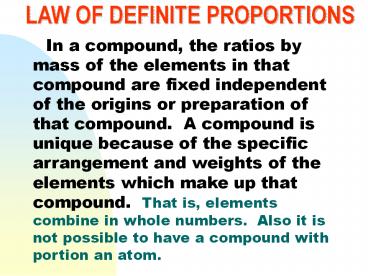LAW OF DEFINITE PROPORTIONS - PowerPoint PPT Presentation
Title: LAW OF DEFINITE PROPORTIONS
1
LAW OF DEFINITE PROPORTIONS
- In a compound, the ratios by mass of the
elements in that compound are fixed independent
of the origins or preparation of that compound.
A compound is unique because of the specific
arrangement and weights of the elements which
make up that compound. That is, elements combine
in whole numbers. Also it is not possible to
have a compound with portion an atom.
2
(No Transcript)
3
LAW OF DEFINITE PROPORTIONS
- Elements combine in specific ratios to form
compounds - Use the Generic equation for percent
- ( portion / total ) 100
- 1. What is the experimental percent of oxygen in
CO2 if 42.0 g of carbon reacted completely with
112.0 g of oxygen? - O (mass of O / mass of CO2) 100
- O 112.0 g O / (42.0 g 112.0 g) CO2 100
72.7 O - 2. What is the theoretical percent of aluminum
in aluminum oxide? - Al (Atomic mass of Al / Formula mass of
Al2O3) 100 - Al (54 amu / 102 amu) 100 52.9
- 3. What is the percent composition of sodium
chloride?
Na 39.3 Cl 60.7
4
LAW OF MULTIPLE PROPORTIONS
- When two elements form a series of compounds,
the masses of the one element that combine with a
fixed mass of the other element stand to one
another in the ratio of small integers. - Iron oxide exists in different ratios with
different properties - FeO and Fe2O3
5
LAW OF CONSERVATION OF MASS
- In every chemical operation an equal quantity of
matter exists before and after the operation.
That is, the amount of matter before a reaction
must equal the amount of matter after a reaction.
No matter is lost. - The total mass of reactants total mass of
products
6
LAW OF CONSERVATION OF MASS
- When 0.0976 g of magnesium was heated in air,
0.1618 g of magnesium oxide (MgO) was produced. - a) what is the mass of oxygen needed to produce
0.1618 g MgO? - Using the LCM
- Total mass reactants total mass products
- mass of Mg mass O mass of MgO
- 0.0976 g Mg mass O 0.1618 g MgO
- mass O 0.1618 g - 0.0976 0.0642 g O
7
Law of conservation of mass Law of definite
proportions
- When 0.0976 g of magnesium was heated in air,
0.1618 g of magnesium oxide (MgO) was produced. - b) what is the percent of Mg in MgO?
- Mg (mass Mg / Mass MgO) 100
- (0.0976g / 0.1618 g) 100 60.3
- c) Using only LDP, what mass of oxygen was
needed to combine with the magnesium? - O 100 MgO - 60.3 Mg 39.7 O
- O (mass O / mass MgO) 100
- 39.7 (mass O / 0.1618 g) 100
- mass O 0.397 ( 0.1618 g) 0.0642 g O
- Same as using the LCM!!
8
PRACTICE PROBLEMS
- Practicing Law of conservation of mass
- ________1. Aluminum metal combines with oxygen to
produce aluminum oxide. If 141.0g of aluminum
yields 266.7 g of aluminum oxide, how many grams
of oxygen were needed? - ________2. Sodium metal reacts with chlorine gas
to produce the salt, sodium chloride. If 15.0 g
of chlorine yields 26.5 g of salt, how much
sodium metal is needed? - Practicing the law of definite proportions
- ________3. What is the experimental percent of
oxygen in a copper oxide if 10.0 g of copper
reacted completely with 2.52 g of oxygen? - _______ 4. Based on question 1, what is the
experimental percent composition of aluminum
oxide? - _______ 5. Calculate the theoretical percent
composition for aluminum chloride and sodium
oxide.
9
PRACTICE PROBLEMS
- Practicing percents
- ________1. Pure gold is too soft a metal for many
uses, so it is alloyed to give it more mechanical
strength. One particular alloy is made by mixing
29.17 g of gold, 3.81 grams of silver, and 5.91 g
of copper. What is the percent of gold in this
mixture? - ________2. If 255 g of a meat sample contains
21.9 g of fat, what percentage of fat is present? - Using the LAWS
- ________3. How many grams of CuO can be obtained
from 1.80 g of copper (use the theoretical
percent composition)? - 4. When aluminum combines with bromine gas, they
produce the substance aluminum bromide, AlBr3.
Write a chemical equation describing this
reaction. - _______ If 56.88 g of aluminum bromide is formed
from 5.75 g of aluminum, how many grams of
bromine was needed?
75.0
8.6
225 g
2Al 3Br2 ? 2AlBr3
51.13 g































